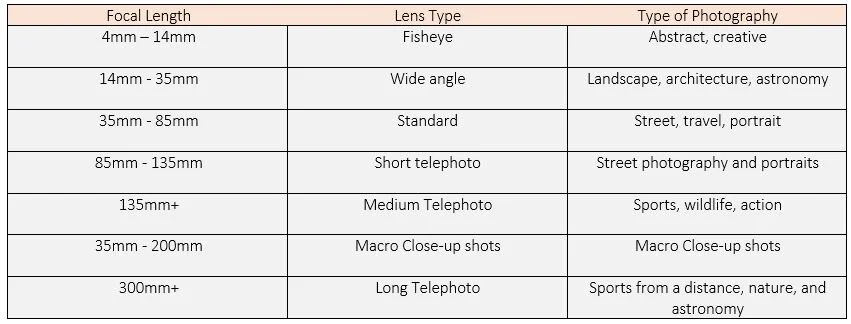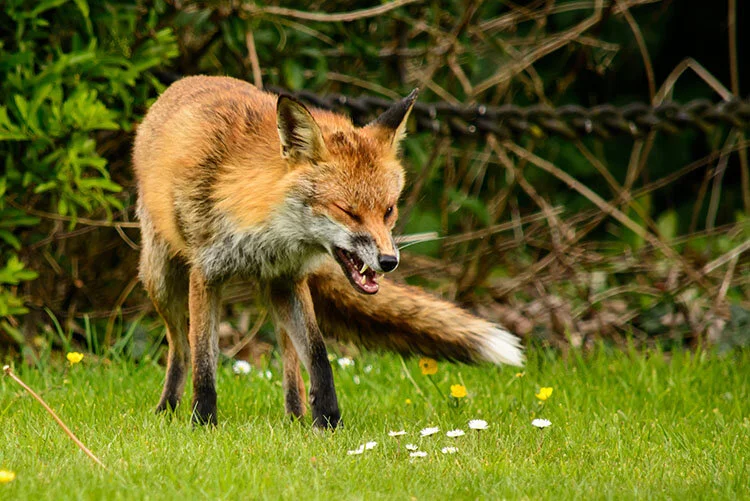Types OF LENSES
Prime and Zoom Lens
To Zoom or not to Zoom? This section will go over the pros and cons of both the Prime and Zoom lenses.
Zoom Lens
Zoom lenses are more versatile and more productive than a Prime lens enabling you to have a more dynamic focal length in one lens. This enables you to capture most images regardless of the distance, as the lens can adjust over a wide range of focal lengths, with the added convenience of never having to switch lenses in the middle of a shoot thus increase the risk of dust getting inside the camera. If the subject is moving towards or away from you the lens can maintain the same composition and relative size within the frame due to being able to adjust the focal length. Something to be aware of with Zoom Lenses, not all Zoom lenses have automatic focus, some are manual focus which means you will need to become adept at adjusting the focus ring to achieve an in-focus photo.
Zoom lenses are generally cheaper but can be more expensive in comparison to Prime Lenses if you wish to achieve similar quality work, that meaning if you wish to have a picture quality at equal measure you will have to pay more for this to be achieved with a Zoom lens. Zoom lenses have more optical elements, and moving components than their Prime lens relative, which leads to a heavier lens, less quality imagery, and more chance for abnormalities to occur. The result is a photo that will be less sharp in comparison to a Prime Lens.
Pros:
Versatile - Can cover a wide range of focal lengths in one lens effectively moving the subject to or away from you.
Probability - A much higher chance of capturing images at any given circumstance due to Zoom lens focal length adaptability.
Cheaper - Generally speaking, Zoom lenses are cheaper than Prime Lenses until you reach the pro-range of Zoom lenses where you will then pay a lot for a Zoom lens with high-quality glass.
Good for Beginners - Zoom lenses allow for less planning and less maneuvering into positions when trying to photograph a subject due to the Zoom lenses having many focal lengths.
Cons:
Heavier - Extra elements and components make for a heavier lens, although the upside is you may only need to carry one lens compared to multiple Prime lenses to cover these focal lengths.
Slower - Zoom lenses are slower than Prime lenses and work less effectively in low-light conditions compared to Prime lenses.
A wider depth of field - the majority of high-end Zoom lenses only allow a wide as f5/6, f4, or f2.8. This results in less pleasing milky or bokeh effects compare to Prime lenses.
Lower quality imagery - Although Zoom lens quality has vastly increased it is still some way of Prime Lens sharpness.
Prime Lenses
Prime lenses are superior to Zoom lenses when it comes to Image quality, potential shallow depth of field, and their lower aperture values such as f/1.2 - f/1.8. There are fewer elements that produce less chromatic aberration and lens distortion that result in a much sharper image. The lenses are also lighter due to fewer elements so if you were to be shooting a subject at the same distance all day it would be less tiresome. Using a Prime lens makes you plan and learn more about a specific genre of photography, this helps you to better understand and achieve successful results and in turn, helps you to visualize the requirements and improves your photography. For example, due to the fixed focal length that Prime lenses have, I have learned more about positioning myself due to the lack of Zoom capability. This is extremely important during Wildlife photography, positioning is key with a Prime lens due to not being able to bring the subject to you by Zoom.
The main downside to the Prime is its lack of versatility which can lead to a lower probability of producing photos due to its lack of being limited to one specific focal length on each lens. The Lack of multiple focal lengths can lead to photo opportunities missed so using Prime lenses requires not just more skill but a good knowledge of the subject you are trying to capture.
Pros:
Higher quality Imagery - Prime Lenses come with Superior Glass and fewer elements with fewer aberrations that result in sharper images.
Faster - Lower aperture values help achieve faster light-gathering which helps to shoot in low-light conditions.
A shallower depth of field - Lower aperture ranges such as f/1.2 - f/1.8 produces better visual milky and bokeh effects on images
Lighter - With fewer elements, the lenses tend to be lighter in comparison to Zoom lenses.
Cons:
Lack of versatility - Using a fixed focal length limits the subject(s) you can capture because you can’t bring the subject to you like with a Zoom lens.
Less probability - Due to the fixed focal length of a Prime lens you are much more likely to miss a photo opportunity than you would if you were using a Zoom lens.
Cost - Prime lenses tend to be more expensive than Zoom lenses due to the quality of the glass and components.
Learning curve - Although you do not have to worry about zooming in and out there is an element of mastery to using a Prime lens and this comes in the form of learning about the subject you are trying to photograph and how to better position yourself to achieve this, this is most important in Wildlife situations.
CHOOSING THE RIGHT LENS
Choosing the right lens is very important for the type of photography you want to focus on. If you were to go out into the field to photograph Wildlife and were using a 4mm - 14mm lens you would manage to capture nothing but wide-angled distorted images showing no Wildlife, just a big open landscape. Now if you were to use a 35mm - 200mm macro lens you could capture beautiful close-up images of flowers or insects. Using a 300mm telephoto lens will help to lessen the disturbance of Wildlife from afar enabling you to view and capture animals and birds. Another consideration would be to think about the aperture rating you will need for the type of photography. The below table is a guideline to give you an idea of what is required for a specific type of photography.
Image left to right - A few of the lenses I use and their purpose.
1. Nikon 50mm f1.8 G AF-S Prime Lens - used for portraits, or general photography when walking the streets.
2. Laowa 15mm f/4.5 Zero-D Shift - my go-to lens for wide-angle photography of Landscapes.
3. Pentax 3.5 - 5.6 / 28 -105 mm - Standard zoom good all-round kit lens.
4. Nikon AF-S Nikkor 300mm 1:4 PF ED - Fantastic telephoto Prime lens for Wildlife and long-range Landscape.
Fisheye Lens
The Fish-eye lens has a high level of distortion, that may not be everyone’s cup of tea, however, if used in certain circumstances it can produce some fascinating and creative images. Fisheye images courtesy of Pinterest, unknown photographers.
Wide-Angle Lens
Wide-Angle Lens is particularly worshipped by Landscape photographers for its wide angle of view. Images on the top row were taken on my Samsung 10+ with pretty impressive results for a Smart Phone. Images on the bottom row were taken with a Laowa 15mm f/4.5 Zero-D Shift Lens on my Nikon D500 which uses an APS-C sensor.
Standard Lens and Short telephoto
The Standard Lens and Short telephoto Lens are good for travel, street, portrait, and even insects, but not macro. Below images were taken on my old Nikon D7100 which was my first DSLR camera and a great camera to start with.
Long Telephoto Lens
This type of lens is primarily used for far-away subjects such as Wildlife. Also, telephoto lenses can be surprisingly good at capturing Astrophotoghy images with the right accessories. There are instances that you can get away with even using a Long Telephoto Lens for insects! A good Telephoto Lens will cost quite a bit, however, it is really worth investing in a good lens especially if the majority of your subjects are from a long distance, or are easily disturbed if you approach too close. My most used lens from my lens kit is the Nikon AF-S Nikkor 300mm 1:4 PF ED and to be quite frank it has been the best Long Telephoto Lens purchase I have made so far. Below is a mix of images taken from that lens, with my Nikon D500.
Things to Note:
Camera mount and Sensor Format
It is very important to note that all lenses will not fit on your camera. To know whether a lens fits on your camera you will first need to know the mount on your camera, you can obtain this inside your camera manual or by searching on google online. My Nikon D500 is a DX series which means it uses a crop sensor (APS- C) and has an F-Mount for the lenses to attach. If I were to look for a new lens for my NikonD500 I would primarily search for F-Mount lenses then make sure that it was compatible with my DX-format (APS-C). Some are compatible with both FX (Full-frame) and DX (crop-sensor) so keep that in mind if you happen to have both a full-frame and crop-sensor camera. Some Lenses from different manufacturers can fit on your camera, the most popular universal lenses are Sigma and Tamron.
Filters
The most commonly used camera filters are Polariser and UV filters. The UV filter helps to filter out Ultraviolet rays from the Sun, however, my main purpose of using a UV filter is to protect the glass of the Lens. A scratched filter is a lot cheaper to replace compared to fixing or replacing a Lens so bear that in mind. Lenses will have a measurement reading on them, normally near the front-end of the Lens and this will tell you the size filter that is required. Some Lenses, however, like the Fish-Eye or Wide-Angle Lenses will not have screw-on filters and require a specialized filter which you will need to obtain the measurements and requirements from the Lens manufacturing book. Be wary of buying cheap filters because the quality of the glass may not be sufficient to maintain your lenses image capturing quality. It would be best to check reviews of a filter of interest to ensure there have been no negative comments regards poor image quality.
Focusing
Not all Lenses have AF (Auto Focus) so be careful if you are not interested or comfortable with using Manual Focus.
Next, we will take a look at accessories for your photography hobby.




















